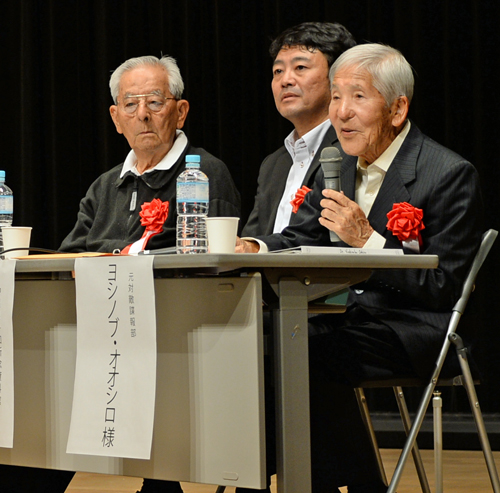Former US soldiers of Okinawan descent; war destroys all

Hawaiians of Okinawan descent Yoshinobu Oshiro (right) and Takejiro Higa (left) told of their experiences as the U.S. military’s interpreter-soldiers at the Okinawa Prefectural Peace Memorial Museum on December 6.
December 7, 2014 Ryukyu Shimpo
The Okinawa Prefectural Peace Memorial Museum held a symposium “Okinawa reflected in the eyes of second-generation Japanese-American Uchinanchu during and after the war” in Itoman on February 6. Takejiro Higa, 91, who served in the Battle of Okinawa in 1945 and called for surrender to residents in Uchinaguchi or Okinawan dialect, and Yoshinobu Oshiro, 86, who served as an interrogator of Japanese soldiers on their return from Siberia, in Maizuru, Kyoto after the end of the war, spoke out about their experiences to about 200 audience members. The two former U.S. soldiers of Okinawan descent stressed that war destroys everything, including people and buildings, and that it should not be allowed to occur again.
The Okinawa Prefectural Government carried out a project of recording the experiences of Japanese Americans, including those of Okinawan descent, who served in the Battle of Okinawa, this year. The symposium is a part of the project. Higa and Oshiro took part in the symposium from Hawaii.
Oshiro, who was born and raised in Hawaii, experienced the Pearl Harbor attack on December 7, 1941. He was enlisted in the U.S. Army in 1946 after the end of the war. When he was assigned as an interpreter-soldier of the CIC in Japan under U.S. military occupation, he undertook interrogation of former Japanese soldiers who had returned from Siberia. In 1947, Oshiro visited for the first time Haebaru Village, the hometown of his parents. “It was the first meeting between us, but his grandmother was willing to hug me. Having seen me in the picture, she recognized me at once. I could only nod to her words because I could not understand Okinawan dialect. I was really happy,” Oshiro said, reflecting on the memory of that time.
Higa was raised in Kitanakagusuku Village, the home of his parents, after he was born in Hawaii. He returned to Hawaii in 1939, avoiding enlistment into the Volunteer Pioneer Youth Army of Manchuria and Mongolia. When he was stationed in Leyte Island, the Philippines, in 1944, he was shocked to see a photograph of Okinawa just after the U.S. military carried out air strikes on October 10. About 90 percent of buildings in Naha City, the capital of Okinawa, were lost to fire and abandonment. “Okinawan relatives and classmates appeared in a dream to me. I was so worried about Okinawa,” he said.
Soon after landing in Okinawa, Higa called out for residents to surrender. “I was struggling physically and emotionally to say it. I did not shoot any bullets. I would be pleased if my work has contributed something to Okinawan people. War destroys everything and it is the most ridiculous thing,” he stressed.
(English translation by T&CT)
Previous Article:20,029 people complete the 30th Naha Marathon
Next Article:Whooper swan resting in Ogimi
[Similar Articles]
- Okinawan American veteran used Uchinaguchi to save local residents during the Battle of Okinawa
- HUOA President couple busy for sister-state events
- One hundred attendees at Hawaii “Irei no Hi” memorial ceremony mourn lives lost in Battle of Okinawa
- Peace Museum exhibits ‘Hawaii’s Uchinanchu and the Battle of Okinawa’
- Bin Konno gives lecture on preserving the essence of Karate at Urasoe symposium
 Webcam(Kokusai Street)
Webcam(Kokusai Street)


